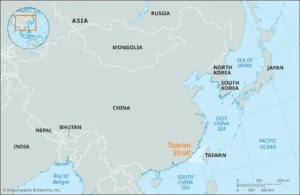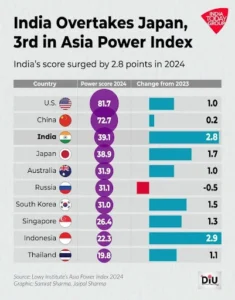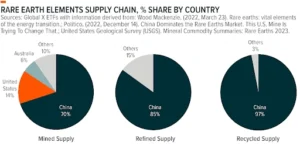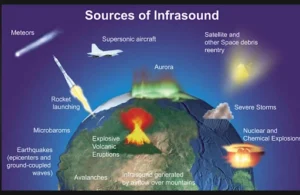UPSC GS 1
Taiwan Strait
- News: Leaders of the G7 nations reiterated the importance of stability and peace in the Taiwan Strait in a joint statement issued recently.
- Taiwan Strait: The Taiwan Strait, also called the Formosa Strait, separates the island of Taiwan from continental Asia.
- Ports: The main ports are Amoy on mainland China and Kao-hsiung in Taiwan.
- Rivers: Several rivers, including the Jiulong and Min rivers from China’s Fujian Province, drain into the Taiwan Strait.

- Islands:
-
- The largest islands on the Taiwan side include Penghu (Pescadores), Xiamen, and Pingtan.
- The Taiwan Strait is a critical corridor connecting the South China Sea to the East China Sea and serves as a busy navigational waterway, with millions of tons of cargo ferried annually.
- The strait is also an important fishing ground in China, home to over a hundred economically significant fish species.
-
- Strait :
-
- A strait is a narrow body of water that connects two larger bodies of water.
- It may be formed by a fracture in an isthmus, a narrow body of land that connects two bodies of water. Tectonic shifts can lead to straits like this.
-
Read also: White Revolution 2.0: New Dairy Frontier for India’s Growth | UPSC
UPSC GS 2
Asia Power Index
- News: India ranked third in the annual Asia Power Index, released by an Australian think-tank, surpassing Japan on the back of strong post-COVID 19 economic growth.
- Asia Power Index:
-
- The Asia Power Index was launched by the Lowy Institute in 2018.
- It is an annual measure of power dynamics in the Asia-Pacific region.
- The Index evaluates 27 countries across the Asia-Pacific, assessing their ability to shape and respond to the external environment.
- It examines both material capabilities and the influence states exert on the international stage.
- The 2024 edition provides one of the most comprehensive assessments of power distribution in the region to date.
- Timor-Leste has been included for the first time, reflecting its growing significance in Southeast Asia.
-
- Determinants of the Index: The Index is divided into two main categories: resource-based and influence-based determinants.

-
-
- Resource-Based Determinants:
- Economic Capability: The core economic strength of a country, measured through indicators like GDP at purchasing power parity (PPP), technological sophistication, and global economic connectivity.
- Military Capability: Evaluates conventional military strength based on defense spending, armed forces, weapon systems, and signature capabilities like long-range power projection.
- Resilience: The internal capacity to deter threats to state stability, including institutional robustness, geopolitical security, and resource security.
- Future Resources: Forecasts the future distribution of resources, including economic, military, and demographic factors projected for 2035.
- Influence-Based Determinants:
- Economic Relationships: The capacity to exercise leverage through trade, investment, and economic diplomacy.
- Defense Networks: The strength of alliances and partnerships, measured through military cooperation and arms transfers.
- Diplomatic Influence: The extent of a country’s diplomatic reach, participation in multilateral forums, and foreign policy ambition.
- Cultural Influence: The ability to shape international public opinion through cultural exports, media, and people-to-people ties.
-
- Overall Power Score: A country’s overall power score is derived from a weighted average of these eight measures, covering 131 individual indicators.
Seva Se Seekhen
- News: Recently, the Department of Youth Affairs, Ministry of Youth Affairs and Sports launched the “Seva Se Seekhen” program under the MY Bharat initiative.
- Launch Date: The “Seva Se Seekhen” program has been launched to encourage youth involvement in meaningful community service and promote social responsibility.
- Launched by: It was introduced by the Department of Youth Affairs under the MY Bharat initiative.
- Aim: The program aims to engage India’s youth in hands-on learning experiences while providing assistance to hospital patients nationwide. It also seeks to increase the utilization of PM-JAY services, improving healthcare access for underprivileged communities.
- Focus: The initiative emphasizes fostering a culture of service (seva), empowering young volunteers to support the nation’s healthcare system.
- Program Impact: It has created 304 experiential learning programs and 2,649 volunteering opportunities. Currently, 1,732 volunteers are actively working across 319 hospitals in 24 states and union territories.
- Leading States: Gujarat leads the program with 273 volunteers deployed across 33 hospitals. Other states with significant participation include Rajasthan, Haryana, Tamil Nadu, and Uttar Pradesh, where volunteers are playing essential roles in healthcare services.
- Mera Yuva Bharat (MY Bharat):
-
- Definition: The Prime Minister Modi launched the Mera Yuva Bharat (MY Bharat), an autonomous body, in 2023 on the National Unity Day.
- Aim:
- To be a technology-driven facilitator for youth development, helping young people contribute towards a “Viksit Bharat” (Developed India).
- Improve the leadership skills through experiential learning by shifting from isolated physical interaction to programmatic skills
- Investing in youth to make them social innovators, and leaders in the communities
- Better alignment between the aspirations of the youth and the community needs
- Enhanced efficiency through Convergence of existing programmes
- Act as a one-stop shop for young people and Ministries
- Create a centralized youth database
- Improved two-way communication to connect youth government initiatives and activities of other stakeholder that engage with youth
- Ensuring accessibility by creating a Phygital Ecosystem – a blend of physical and digital experiences.
- Beneficiaries: Beneficiaries are youth in the age group of 10-19 years, while the platform benefits youth aged 15-29 years as per the National Youth Policy.
-
Minerals Security Finance Network
- News: India is now formally a part of the Minerals Security Finance Network.
- Definition & Aim:
-
- The Minerals Security Finance Network is a new initiative emerging from the Minerals Security Partnership (MSP).
- Its primary objective is to strengthen global cooperation in securing critical mineral supply chains.
- The network fosters collaboration between institutions from the Indo-Pacific region and Europe, encouraging cooperation, information exchange, and co-financing efforts.
-
- Member Countries: The partnership includes 13 countries and the European Commission. These are the United States of America, Australia, Canada, Estonia, Finland, France, Germany, India, Italy, Japan, the Republic of Korea, Norway, Sweden, the United Kingdom, and the European Union (represented by the European Commission).
- Significance to India:
-
- The initiative aids India in diversifying and securing critical mineral supplies from nations like Argentina, Chile, Australia, and select African countries.
- Kazakhstan, located in Central Asia, is also being considered as a potential source for India’s mineral needs.
-
- Minerals Security Partnership (MSP):
-
- Established by the US in 2022, MSP is a framework designed to bolster critical mineral supply chains.
- The alliance was announced by the United States and its key partner countries in June 2022.
-
- Goal of the Alliance:
-
- The MSP aims to ensure that critical minerals are produced, processed, and recycled in a way that allows countries to fully realize the economic development benefits of their geological resources.
- The focus is on securing supply chains for minerals such as:
- Cobalt
- Nickel
- Lithium
- Rare earth minerals (17 in total)
- While cobalt, nickel and lithium are required for batteries used in electric vehicles, rare earth minerals are critical, in trace amounts, in the semiconductors and high-end electronics manufacturing.
-
- India’s Role: India was inducted into the MSP in June 2023, strengthening its ability to secure critical mineral supplies.

- Rare Earth:
-
- Rare earth elements are a group of metals that are critical ingredients for a greener economy, and the location of the reserves for mining are increasingly important and valuable.
- It comprises 17 elements and are classified as light RE elements (LREE) and heavy RE elements (HREE).
- Some REs are available in India such as lanthanum, cerium, neodymium, praseodymium and samarium, while others such as dysprosium, terbium, europium that are classified as HREE are not available in Indian deposits in extractable quantities.
- Currently, there is dependence on countries such as China for HREE, which is one of the leading producers of RE with an estimated 70% of the global production.
-
Women in Space Leadership Programme (WiSLP)
- News: India and the UK recently launched a Women in Space Leadership Programme (WiSLP) to create a gender-inclusive environment in space sciences.
- Definition: Women in Space Leadership Programme (WiSLP) has been launched as part of the UK-India Education and Research Initiative (UKIERI).
- Aim:
-
- Strengthening gender-inclusive practices in space sciences by developing a strategic leadership framework.
- The programme will aid 250 early career researchers (ECRs) to become better equipped to take up leadership roles and navigate gender biases and associated barriers.
-
- Participating Agencies: Department of Science and Technology (DST) has partnered with the British Council.
- Pillars: This programme is underpinned by three foundational pillars:
-
- Intersectionality or understanding of different aspects of women’s identities
- Collaborative culturally sensitive approaches that respond to opportunities and challenges in India
- Using leadership theory from both social science and STEM to support female scientists to become more confident about their leadership abilities.
-

- UK-India Education and Research Initiative (UKIERI):
- Definition: UKIERI is the UK and India’s flagship bilateral collaboration program focused on education and research, founded in 2006.
- Objective: The initiative aims to strengthen education and research collaboration between the UK and India, helping both countries achieve their knowledge ambitions.
- Implementation:
-
- UKIERI has been implemented in three phases from 2006 to 2022, with the fourth phase launched in 2023.
- The fourth phase of UKIERI aims to enhance the bilateral relationship between the UK and India in education, research, and innovation while addressing shared global challenges and promoting sustainable development.
-
UPSC GS 3
Exostoma Sentiyonoae
- News: A new species of glyptosternine catfish, Exostoma sentiyonoae, has been discovered in the Dzuleke River, a tributary of the Barak River in Nagaland.
- Exostoma Sentiyonoae: Exostoma Sentiyonoae is a newly described fish species distinguished by several unique characteristics.
- Key Identifying Features include:
-
- Adipose fin attached to the upper procurrent caudal-fin rays.
- Tubercles present on the dorsal-fin spine.
- Slender head and a long distance between the dorsal and adipose fins.
- Small eyes and the presence of 41 vertebrae.
- Researchers differentiated E. sentiyonoae from related species in the Salween drainage of Myanmar and Thailand, namely E. berdmorei and E. gaoligongense.
- E. sentiyonoae differs from E. berdmorei by having:
- A shorter dorsal-fin base.
- A longer dorsal-adipose fin distance.
- Smaller eyes.
- Compared to E. gaoligongense, the new species has:
- A shorter pectoral-pelvic distance.
- Smaller eyes.
-
- Biodiversity and Discovery:
-
- E. sentiyonoae is the fourth species of the genus Exostoma described from the Barak drainage, underlining the rich biodiversity of the region.
- It is also the first known member of the Exostoma genus discovered in the Dzuleke River in Nagaland.
-
Infrasound
- News: In November 2024, the Comprehensive Test Ban Treaty Organization (CTBTO) will hold a workshop for scientists on using ‘infrasound’.
- Infrasound:
-
- Infrasound refers to sound waves with very low frequencies, in contrast to the more commonly known ultrasound.
- It can be produced by various natural and man-made phenomena, such as:
- Passing meteors
- Storms
- Auroras in the northern regions
- Volcanoes
- Earthquakes
- Nuclear explosions
- Infrasonic waves cause small changes in atmospheric pressure, which can be detected by microbarometers.
- These sounds can travel long distances without significant loss of energy, making them useful for detecting distant nuclear explosions.
-

- CTBTO and Infrasound Detection:
-
- The Comprehensive Nuclear-Test-Ban Treaty Organization (CTBTO) uses infrasound technology as part of its International Monitoring System (IMS).
- The Infrasound Network being developed by CTBTO will be the only global monitoring network of its kind.
- It plans to include 60 array stations across 35 countries for global monitoring.
-
- Applications of Infrasound:
-
- Structural health monitoring: Infrasound can be used to check the integrity of buildings, dams, and bridges by detecting internal stress, cracks, or defects, as it can pass through dense materials.
- Aerospace: In the aerospace industry, low-frequency sounds generated during a rocket’s lift-off can help monitor the stress and behaviour of the rocket or detect aerodynamic instabilities in aircraft.
- Mining: Infrasound can be utilized to check the stability of mine shafts or to determine whether a dynamite blast was successful.
- Wildlife tracking: This sound has also been applied in tracking wildlife, such as monitoring the movement of whales over long distances.
-
Read also: Overwork in India: Threat to Employee Health & Productivity | UPSC
Periodic Labour Force Survey (PLFS)
- News: The Periodic Labour Force Survey (PLFS) for the period between July 2023 and June 2024 has been released by the Labour Bureau recently.
- Launch: Considering the importance of availability of labour force data at more frequent time intervals, National Sample Survey Office (NSSO) launched Periodic Labour Force Survey (PLFS) in April 2017.
- Aim:
-
- To estimate the key employment and unemployment indicators (viz. Worker Population Ratio, Labour Force Participation Rate, Unemployment Rate) in the short time interval of three months for the urban areas only in the ‘Current Weekly Status’ (CWS).
- To estimate employment and unemployment indicators in both ‘Usual Status’ (ps+ss) and CWS in both rural and urban areas annually.
-
- Agency: This survey is conducted by the National Sample Survey (NSO), working under the Ministry of Statistics and Programme Implementation (MoSPI).
- Indicators: The indicators of this survey are:
-
- Labour Force Participation Rate (LFPR): LFPR is defined as the percentage of persons in labour force (i.e. working or seeking or available for work) in the population.
- Worker Population Ratio (WPR): WPR is defined as the percentage of employed persons in the population.
- Unemployment Rate (UR): UR is defined as the percentage of persons unemployed among the persons in the labour force.
- Current Weekly Status (CWS): The activity status determined on the basis of a reference period of last 7 days preceding the date of survey is known as the current weekly status (CWS) of the person.
-
- Key Findings:
-
- Increasing Trend in Labour Force Participation Rate (LFPR) for persons of age 15 years and above: In rural areas, LFPR increased from 50.7% in 2017-18 to 63.7% in 2023-24 while for urban areas it increased from 47.6% to 52.0%.
- Increasing Trend in Worker Population Ratio (WPR) for persons of age 15 years and above: In rural areas, WPR increased from 48.1% in 2017-18 to 62.1% in 2023-24 while for urban areas it increased from 43.9% to 49.4%.
- Decreasing Trend in Unemployment Rate (UR) for persons of age 15 years and above: In rural areas, UR decreased from 5.3% in 2017-18 to 2.5% in 2023-24 while for urban areas it decreased from 7.7% to 5.1%. UR for male in India decreased from 6.1% in 2017-18 to 3.2% in 2023-24 and corresponding decrease for female was from 5.6% to 3.2%.
-

